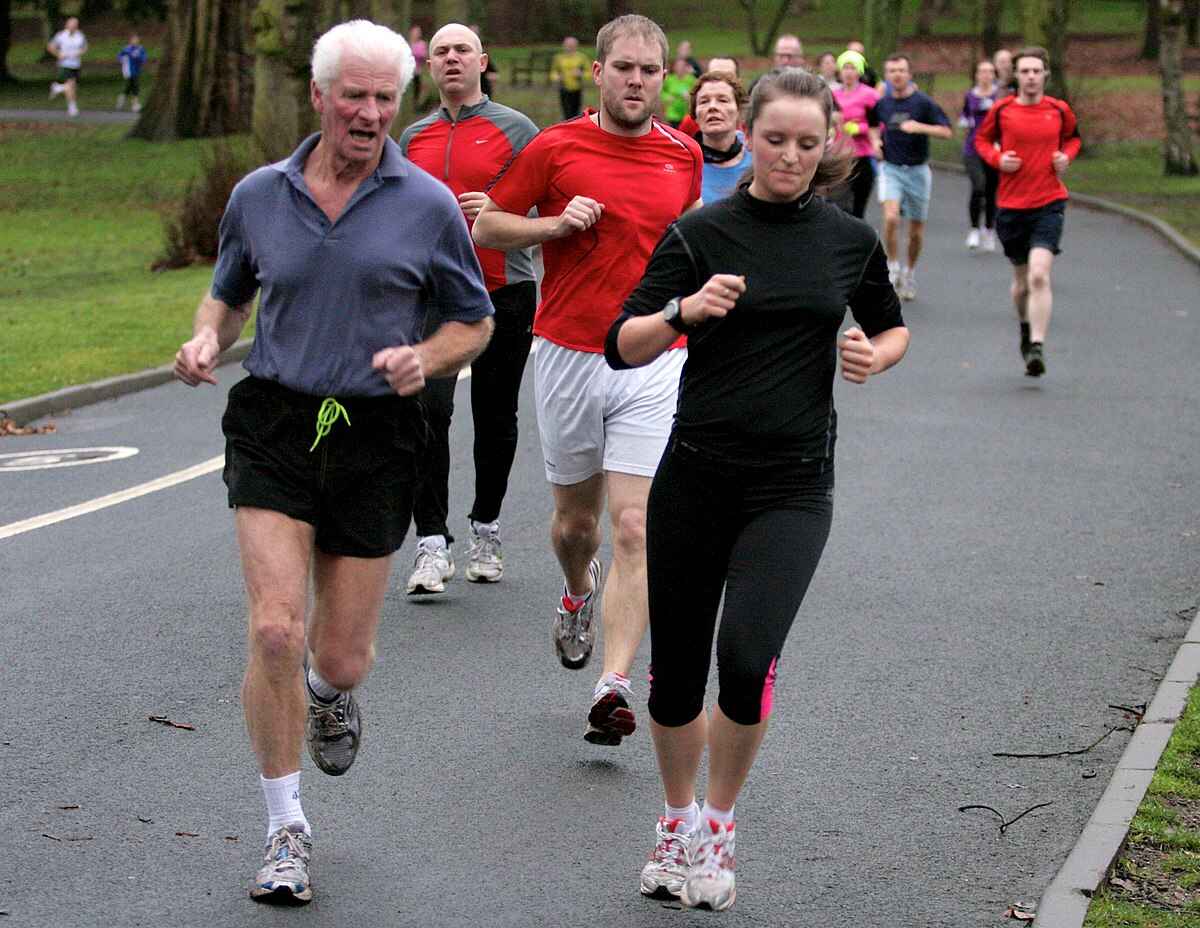

Featured
How To Run In A 5K Run Walk Program
Modified: October 24, 2023
Looking to get featured in a 5K run walk program? Discover how to run in the program and achieve your fitness goals with our step-by-step guide.
Introduction
Welcome to the world of 5K run walk programs! Whether you’re a seasoned runner looking to improve your speed and endurance or a beginner who wants to kickstart their fitness journey, a 5K run walk program is a fantastic way to achieve your goals.
A 5K race is a distance of 5 kilometers, which is roughly equivalent to 3.1 miles. It’s a popular choice for many runners and fitness enthusiasts as it offers a manageable distance for both beginners and more experienced runners. By incorporating a combination of running and walking intervals, the program allows participants to gradually build their stamina, improve their cardiovascular fitness, and prevent any burnout that can occur with constant running.
Participating in a 5K run walk program offers numerous benefits, both physical and mental. First and foremost, it provides an opportunity to improve your overall fitness level. The program will challenge and push your body, leading to cardiovascular improvements, increased strength, and enhanced endurance. Regular participation in the program can also contribute to weight loss and help maintain a healthy body composition.
In addition to the physical benefits, the 5K run walk program can also have a positive impact on your mental well-being. Engaging in regular exercise releases endorphins, which are the body’s natural mood boosters. Running and walking in nature can be a form of meditation, providing an escape from daily stressors and fostering a sense of calm and clarity.
Moreover, training for a 5K can be a great way to challenge yourself and set personal goals. Whether your goal is to complete the race for the first time, improve your previous race time, or simply have fun and enjoy the experience, the program allows you to tailor your training to your own objectives. It’s a journey of self-discovery, self-discipline, and pushing your limits.
In the following sections, we’ll delve deeper into the components of a 5K run walk program and provide you with a detailed guide to help you achieve success in your race. From setting realistic goals to creating a personalized training schedule, and from optimizing your race day strategy to proper recovery, we’ll cover everything you need to know to run your best 5K race.
Benefits of the 5K Run Walk Program
The 5K run walk program offers a multitude of benefits for participants, regardless of their fitness level or running experience. Let’s explore some of the advantages that this program can bring:
- Improved Cardiovascular Fitness: Engaging in regular exercise that combines running and walking intervals helps to strengthen your heart and improve cardiovascular endurance. The gradual increase in intensity throughout the program allows your body to adapt and become more efficient in utilizing oxygen, leading to a healthier cardiovascular system.
- Increased Stamina: The combination of running and walking in the program gradually builds your stamina over time. Your body adapts to the demands of the training, allowing you to run for longer periods without feeling exhausted. With consistent training, you’ll notice significant improvements in your endurance and ability to sustain a higher level of physical activity.
- Weight Loss and Body Composition: The 5K run walk program can be an effective tool for those who are looking to shed some pounds or achieve a healthier body composition. Running and walking are both excellent calorie-burning activities, and when combined with a balanced diet, can contribute to weight loss and muscle toning.
- Reduced Risk of Chronic Conditions: Regular physical activity, such as the 5K run walk program, has been shown to reduce the risk of chronic conditions like heart disease, diabetes, and certain types of cancer. It helps to control blood pressure, improve insulin sensitivity, and increase the levels of “good” cholesterol in the body, all of which promote better overall health.
- Enhanced Mental Well-being: Engaging in physical exercise has long been associated with better mental health. Running and walking, in particular, have been shown to release endorphins, which are natural mood enhancers. The 5K run walk program provides a fantastic opportunity to reduce stress, boost your mood, and improve your overall well-being.
- Stress Relief and Mental Clarity: Training for a 5K race can provide a much-needed break from the stresses of everyday life. It allows you to focus on yourself, your goals, and the present moment. Running and walking outdoors in nature can be a meditative experience, providing mental clarity, reducing anxiety, and promoting a sense of peace.
- Social Connection: Participating in a 5K run walk program can be a fantastic way to meet like-minded individuals and become part of a supportive community. Joining a local running group or signing up for a race can provide you with the opportunity to make new friends, share your journey, and even participate in charity events.
These are just a few of the many benefits that the 5K run walk program can offer. By committing to the program and staying consistent with your training, you’ll not only improve your physical fitness but also experience positive changes in your mental and emotional well-being. So lace up your shoes, embrace the journey, and reap the rewards of your hard work!
Setting Goals for the 5K Run Walk Program
Setting clear and achievable goals is essential for a successful 5K run walk program. Whether you’re a beginner or an experienced runner, having specific targets to work towards will keep you motivated and focused throughout your training. Here are some tips to help you set effective goals for your 5K race:
- Assess Your Current Fitness Level: Start by evaluating your current fitness level and running experience. Consider factors such as your endurance, running speed, and overall physical fitness. This will help you determine a realistic starting point and understand the areas you need to work on.
- Identify Your Motivation: Ask yourself why you want to participate in a 5K race. Is it to challenge yourself and push your limits? Are you looking to improve your overall health and fitness? Are you raising money for a cause? Identifying your motivation will help you set meaningful goals that align with your personal aspirations.
- Set Overall Race Goal: Think about what you want to achieve on race day. Do you aim to complete the 5K race without stopping, beat a certain time, or simply have fun and enjoy the experience? Define your overall race goal, keeping in mind that it should be challenging yet attainable.
- Break It Down into Milestones: Once you have your overall race goal, break it down into smaller milestones. For example, if your goal is to complete the race in under 30 minutes, you can set a milestone of running a 5K distance in 35 minutes within a certain timeframe. These milestones will help you track your progress and provide a sense of accomplishment along the way.
- Consider Timeframe: Determine how much time you have to train for the 5K race. The duration of your program will influence the intensity and frequency of your training sessions. Be realistic about what you can achieve within the given timeframe, taking into account any other commitments or potential obstacles you may encounter.
- Make Your Goals SMART: Apply the SMART goal-setting framework to your 5K run walk program. SMART stands for Specific, Measurable, Attainable, Relevant, and Time-bound. Ensure that your goals are clear and specific, measurable so you can track your progress, attainable considering your current fitness level, relevant to your overall motivations, and time-bound with a specific deadline.
- Adjust According to Progress: Be flexible with your goals and adjust them as needed. As you progress through the program, you may realize that you need to challenge yourself more or set new milestones based on your improved capabilities. Regularly assess your progress and make adjustments accordingly to ensure your goals remain relevant and keep you motivated.
Remember, goal setting is not just about the end result; it’s about the journey as well. Embrace the process, celebrate your achievements along the way, and stay motivated by challenging yourself. By setting clear goals, you’ll have a roadmap to guide you through your 5K run walk program and ultimately reach your full potential on race day.
Creating Your Training Schedule
One of the key components of a successful 5K run walk program is creating a training schedule that suits your individual needs and goals. A well-designed schedule will help you gradually build your fitness and avoid overexertion. Here are some steps to help you create an effective training schedule:
- Evaluate Your Availability: Assess your weekly schedule and determine how many days per week you can dedicate to training. Consider any other commitments, such as work, family, or social activities. It’s important to find a balance that allows you to have consistent training sessions without overwhelming your schedule.
- Start with a Baseline: Determine the amount of time you can comfortably run or walk without feeling overly fatigued. This will serve as your starting point. For beginners, it’s recommended to start with shorter workout durations and gradually increase them as your fitness improves.
- Gradually Increase Intensity and Duration: A 5K run walk program typically lasts around 6-8 weeks. Aim to gradually increase both the intensity and duration of your workouts over the course of your training. This will help your body adapt to the demands of running and walking and prevent injuries.
- Alternate Running and Walking: Incorporate both running and walking intervals into your training schedule. Start with a run-walk ratio that feels comfortable for you, such as 1 minute of running followed by 1 minute of walking. As your fitness improves, you can gradually increase the running intervals and decrease the walking intervals.
- Include Rest Days: Rest days are just as important as training days. They allow your body to recover and adapt to the stress of running. Plan for at least one or two rest days per week to prevent overtraining and reduce the risk of injury.
- Consider Cross-Training: Include cross-training activities in your schedule to improve overall fitness and prevent boredom. Activities such as cycling, swimming, strength training, or yoga can complement your running and provide a well-rounded training routine.
- Listen to Your Body: Pay attention to how your body feels during and after each workout. If you experience persistent pain or discomfort, it’s important to take a break and allow your body to recover. Pushing through pain can lead to more serious injuries.
- Track Your Progress: Keep a training journal or use a running app to track your workouts. This will allow you to see your progress, identify areas for improvement, and stay motivated as you see your fitness improve over time.
Remember, a training schedule should be adaptable to your individual needs and preferences. It’s important to find a balance between challenging yourself and avoiding burnout. Regularly reassess your schedule and make adjustments as needed to keep your training effective and enjoyable.
Week 1: Building a Foundation
Week 1 of your 5K run walk program is all about building a solid foundation and establishing good habits for your training journey. This week sets the tone for the rest of the program, so it’s important to start off strong. Here’s a breakdown of what to focus on during Week 1:
- Assess Your Fitness Level: Start by assessing your current fitness level. This will help you determine the appropriate intensity and duration for your training sessions. If you’re new to running or have been inactive for a while, start with shorter intervals of running and walking.
- Plan Your Training Schedule: Set aside specific days and times dedicated to your training. Consistency is key, so aim for at least three to four training days this week. Allow for rest days in between to give your body time to recover.
- Warm up and Cool Down: Prior to each workout, warm up with some dynamic exercises such as leg swings, walking lunges, and arm circles. After your workout, cool down with some static stretches to help prevent muscle soreness.
- Run-Walk Intervals: Start with a run-walk ratio that feels comfortable for you. For example, you might try running for 1 minute followed by walking for 2 minutes. Repeat this interval for the duration of your workout. Remember to listen to your body and adjust the intervals as needed.
- Focus on Proper Form: Pay attention to your running form during the running intervals. Keep your body relaxed, with your shoulders down and your gaze forward. Maintain a steady, comfortable pace, and try to avoid heel striking by landing lightly on mid-foot.
- Gradually Increase Duration: Throughout the week, gradually increase the total duration of your running intervals and reduce the walking intervals. The goal is to progress at a pace that challenges you but is still manageable.
- Stay Hydrated and Fuel Your Body: Drink plenty of water before, during, and after your workouts to stay hydrated. It’s also important to fuel your body with nutritious foods to support your training. Opt for a balanced diet that includes a mix of carbohydrates, protein, and healthy fats.
- Listen to Your Body: Pay attention to any signs of fatigue or discomfort during your workouts. It’s normal to feel some muscle soreness, but be cautious of any sharp or persistent pain. If needed, adjust your training intensity or take an extra rest day to allow for proper recovery.
By the end of Week 1, you should feel more comfortable with running and walking intervals and have established a training routine. Remember to take it one step at a time and enjoy the process. Stay motivated and positive as you progress towards your 5K race goal.
Week 2: Increasing Endurance
Week 2 of your 5K run walk program focuses on gradually increasing your endurance. As you continue to build a solid foundation in your training, it’s time to challenge yourself and push your limits. Here’s what you can expect from Week 2:
- Assess Your Progress: Take a moment to evaluate your progress from Week 1. Reflect on any improvements you’ve noticed in your running and walking intervals, as well as your overall stamina and recovery.
- Set Realistic Goals: Based on your progress, set realistic goals for Week 2. These goals can include increasing the duration of your running intervals, reducing your walking intervals, or even aiming to complete longer total workout durations.
- Progressive Overload: To continue improving your endurance, gradually increase the intensity and duration of your workouts. Increase your running intervals by a small amount, such as 30 seconds, and decrease your walking intervals accordingly.
- Incorporate Long Runs: Week 2 is a good time to introduce a longer run or walk session into your schedule. This session should be at a slower pace and a longer duration than your other workouts during the week. It will help build endurance and mental stamina.
- Consistency is Key: Stick to your training schedule and aim for at least three to four training sessions this week. Consistency is important for building endurance, so try not to skip any workouts.
- Embrace Interval Training: Consider incorporating interval training into your workouts. This involves increasing your running speed for short bursts, followed by a recovery period at a slower pace. Interval training helps improve your cardiovascular fitness and overall running performance.
- Focus on Breathing: Pay attention to your breathing during your runs. Aim for deep belly breathing, inhaling through your nose and exhaling through your mouth. This will help provide adequate oxygen to your muscles and improve your endurance.
- Stay Hydrated and Fuel Your Body: Hydration and nutrition continue to be important in Week 2. Drink water before, during, and after your workouts, and replenish your body with nutrient-rich foods to support your training.
- Listen to Your Body: As you challenge yourself and increase your intensity, it’s crucial to listen to your body. If you’re feeling excessively fatigued or experiencing any pain, take an extra rest day or modify your workouts. Pushing through pain can lead to injuries.
By the end of Week 2, you should notice improvements in your endurance and overall stamina. It’s normal to feel a bit fatigued, but remember to stay focused and motivated. Keep pushing yourself within your limits and embrace the progress you’re making.
Week 3: Interval Training
Week 3 of your 5K run walk program introduces the concept of interval training. Interval training involves alternating between periods of high-intensity running and periods of active recovery. This training method is effective for improving speed, endurance, and overall fitness. Here’s what you can expect from Week 3:
- Assess Your Progress: Take a moment to assess your progress from the previous weeks. Notice any improvements in your endurance, running pace, and recovery time. Use this as motivation to push yourself further during Week 3.
- Understanding Interval Training: Interval training involves alternating between high-intensity running intervals and periods of active recovery. The high-intensity intervals should be challenging but sustainable, while the recovery periods allow your body to rest and prepare for the next interval.
- Design Your Intervals: Decide on the duration and intensity of your intervals. Start with a shorter high-intensity interval, such as 30 seconds, followed by a longer recovery period, such as 90 seconds. As you progress throughout the week, gradually increase the duration of your high-intensity intervals and decrease the duration of your recovery periods.
- Find the Right Effort Level: During the high-intensity intervals, aim for about 80-90% of your maximum effort. This should feel challenging but sustainable. During the recovery periods, keep your pace at a comfortable, relaxed level to allow for active recovery.
- Alternate Intervals: During your workouts, alternate between the high-intensity intervals and the recovery periods. Pay attention to your body and adjust the intervals as needed. Remember to maintain proper form and breathing during the high-intensity intervals.
- Keep Track of Your Intervals: Use a timer or a running app to keep track of your intervals. This will help you stay on track and monitor your progress. Consider using markers, such as trees or lampposts, to help you measure the distance covered during each interval.
- Combine Interval Training with Your Regular Runs: Interval training can be incorporated into your regular runs or performed as standalone workouts. Experiment with different combinations to keep your training varied and challenging.
- Rest and Recovery: Allow time for proper rest and recovery between interval training sessions. Your body needs time to repair and adapt to the high-intensity efforts. Aim for at least one or two days of rest or light activity to prevent overtraining and reduce the risk of injury.
- Stay Hydrated and Fuel Your Body: As always, hydration and nutrition play a vital role in your training. Drink water before, during, and after your workouts, and fuel your body with balanced meals and snacks to support your energy levels and recovery.
By the end of Week 3, you should notice improvements in your speed, endurance, and overall fitness. Interval training can be challenging, but it is a highly effective method for enhancing your race performance. Embrace the intensity and enjoy the benefits of this training technique.
Week 4: Hill Training
Week 4 of your 5K run walk program focuses on incorporating hill training into your workouts. Hill training is an excellent way to build strength, improve your running technique, and increase your overall endurance. Here’s what you can expect from Week 4:
- Assess Your Progress: Take a moment to evaluate your progress so far. Notice any improvements in your endurance, speed, and recovery time. Reflect on your achievements and use them as motivation to continue pushing yourself during Week 4.
- Understanding Hill Training: Hill training involves running uphill to challenge your muscles and cardiovascular system. Running uphill recruits different muscle groups and forces you to work harder, building strength and increasing your running economy.
- Choose Your Hill: Find a hill that is safe, with a moderate incline. It should be long enough to provide a challenge but not too steep to risk injury. A gradual incline is ideal for hill training.
- Warm Up Properly: Before starting your hill training, make sure to warm up properly. Include dynamic stretches and exercises to activate your muscles and prepare your body for the uphill effort.
- Start with Short Intervals: Begin your hill training by running uphill for short intervals, such as 30 seconds or 1 minute. Focus on maintaining good form, keeping your chest up, and driving your knees forward.
- Focus on Cadence: Pay attention to your cadence (the number of steps per minute) when running uphill. Aim for a slightly faster cadence than on flat terrain to maintain your momentum and increase your power.
- Use Proper Recovery: After each uphill interval, recover by walking or jogging back down the hill. This active recovery allows your heart rate to lower while still keeping your muscles engaged.
- Gradually Increase Intensity: Throughout the week, gradually increase the intensity and duration of your hill intervals. Challenge yourself to run uphill for longer intervals as you gain more strength and confidence.
- Mix Hill Training with Flat Runs: Incorporate the hill training sessions into your regular runs. You can start with a warm-up jog on flat terrain, then move to the hill for the intervals, and finish with a cool-down jog on flat ground.
- Hydrate and Fuel Properly: Stay hydrated before, during, and after your workouts, especially during hill training when the intensity is higher. Fuel your body with nutritious meals and snacks to support your energy levels and recovery.
- Listen to Your Body: As always, it’s important to listen to your body and adjust your training if needed. If you feel excessive fatigue or experience any pain, take an extra rest day or modify your workouts to prevent injury.
By the end of Week 4, you should notice improvements in your overall strength, endurance, and running technique. Hill training can be challenging but highly rewarding. Embrace the challenge, stay focused, and enjoy the benefits that come with conquering the hills!
Week 5: Speed Work
Week 5 of your 5K run walk program introduces speed work to help you improve your running pace and boost your overall speed. Speed work involves incorporating faster-paced intervals into your training, pushing your body to new limits. Here’s what you can expect from Week 5:
- Assess Your Progress: Take a moment to reflect on your progress so far. Notice any improvements in your endurance, hill running, and overall fitness. Use your achievements as motivation to push yourself further during Week 5.
- Understanding Speed Work: Speed work involves alternating between bursts of faster running and periods of recovery. It challenges your cardiovascular system, increases your lactate threshold, and improves your running economy.
- Choose Your Speed Workouts: There are different types of speed workouts you can incorporate, such as tempo runs, fartleks, and track intervals. Choose one or a combination based on your preferences and goals.
- Tempo Runs: Tempo runs involve running at a comfortably hard pace, slightly faster than your usual training pace. Start with a 10-15 minute warm-up, then maintain your tempo pace for a sustained period, typically 20-30 minutes, before cooling down with a 10-15 minute jog.
- Fartleks: Fartleks are unstructured speed workouts where you vary your pace throughout your run. Choose landmarks or time intervals and alternate between a faster pace and an easier pace. Be creative and have fun with the variations in speed.
- Track Intervals: Find a local track or measured route and run intervals at a faster pace. Start with shorter intervals, such as 200 meters or 400 meters, at your desired pace, followed by a recovery jog or walk. Gradually increase the distance and intensity of your intervals as you progress.
- Proper Warm-up and Cool Down: Before and after your speed workouts, make sure to warm up with dynamic exercises and a short jog to activate your muscles and prepare your body. Cool down with a gentle jog and static stretches to aid in recovery.
- Focus on Form: Pay attention to your form during speed work. Maintain proper running posture, engage your core, and drive your arms forward and back. Focus on running efficiently and powerfully to maximize your speed.
- Gradually Increase Intensity: Throughout the week, gradually increase the intensity and duration of your speed intervals. Challenge yourself to run at a slightly faster pace and increase the distance or duration of your intervals as you build more confidence.
- Take Adequate Recovery: Allow ample time for recovery between speed workouts. Your body needs time to repair and adapt to the high-intensity efforts. Consider scheduling easier run or rest days between speed workouts.
- Stay Hydrated and Fuel Properly: Proper hydration and nutrition are crucial during speed work. Drink water before, during, and after your workouts, and fuel your body with balanced meals and snacks to support your energy levels and recovery.
By the end of Week 5, you should notice improvements in your overall speed, running economy, and mental toughness. Speed work can be challenging but rewarding. Embrace the intensity, stay focused, and enjoy the benefits that come with pushing your limits!
Week 6: Tapering and Final Prep
Week 6 of your 5K run walk program marks the final week of intense training before your race. It’s a crucial time to allow your body to rest and recover while fine-tuning your preparations. Here’s what you can expect from Week 6:
- Assess Your Progress: Take a moment to reflect on your journey so far. Notice how far you’ve come, celebrate your achievements, and acknowledge the progress you’ve made. Use this as motivation for the final week of training.
- Tapering: Tapering refers to the reduction in training volume and intensity in the week leading up to your race. Cut back on your mileage and intensity to allow your body to recover fully before the big day. The focus shifts from building fitness to maintaining it.
- Reduce Your Mileage: Gradually reduce your mileage during Week 6. Your longest training run should occur early in the week, while the rest of the week consists of shorter, easy-paced runs. This allows your muscles to recover and replenish glycogen stores.
- Keep Your Legs Fresh: Engage in light cross-training activities or active rest days to keep your legs fresh. This can include activities such as swimming, cycling, or gentle yoga. Avoid any high-impact activities that may risk injury.
- Focus on Recovery: Prioritize recovery during the taper week. Make sure to get enough sleep, eat nutritious foods, and stay hydrated. Pay attention to any niggles or potential injuries and take care of them with rest, ice, and gentle stretching.
- Mental Preparation: Use this week to visualize your race and mentally prepare yourself. Visualize yourself running confidently and achieving your race goals. Create a positive mindset and focus on the excitement and enjoyment of the upcoming race.
- Review the Course: Familiarize yourself with the race course if possible. Study the elevation profile, landmarks, and any challenging sections. Knowing what to expect can help you plan your strategy and feel more comfortable on race day.
- Plan Your Race Day Logistics: Plan your race day logistics, including transportation, bib pickup, and pre-race fueling. Lay out your race attire, prepare your running gear, and make sure everything you need is ready before the race day morning.
- Practice Pacing: Use one or two training sessions during the week to practice your target race pace. This will help you establish a comfortable rhythm and get a sense of your goal pace before the race.
- Stay Positive and Confident: Keep a positive mindset and believe in your training. Have confidence in the work you have put in over the past weeks. Trust in your abilities and stay focused on your race day goals.
- Socialize and Have Fun: Connect with other runners, join group runs, or engage with online running communities. Surround yourself with positive energy and enjoy the camaraderie of fellow participants.
By the end of Week 6, you should feel physically and mentally prepared for your 5K race. The tapering period allows your body to rest and recover, ensuring that you show up on race day feeling fresh and ready. Stay positive, stay focused, and enjoy the excitement and fulfillment of your well-deserved race day experience!
Race Day Tips and Strategies
It’s finally here – race day! After weeks of training and preparation, it’s time to put your hard work to the test. Follow these race day tips and strategies to help you perform your best and make the most of your 5K experience:
- Arrive Early: Give yourself plenty of time to arrive at the race venue, collect your bib, and familiarize yourself with the surroundings. Arriving early helps reduce pre-race stress and allows you to get in the right mindset.
- Warm Up: Before the race, engage in a light warm-up routine to activate your muscles and get your body ready to run. Include dynamic stretches, a short jog, and some strides to get your heart rate up.
- Stick to Familiar Foods: Race day is not the time to experiment with new foods or drinks. Stick to what you know your body can handle and what has worked well during your training. Eat a light, easily digestible meal a couple of hours before the race.
- Stay Hydrated: Drink water leading up to the race, but be mindful not to overdo it to avoid feeling bloated. Sip on water in the final hour before the race to stay hydrated but not too full.
- Start Steady: When the race begins, resist the urge to go out too fast. Start at a comfortable pace, allowing yourself to settle into a rhythm. You can always pick up the pace later if you’re feeling good.
- Find Your Self-Paced: As the race progresses, find a pace that feels challenging but sustainable for you. Listen to your body and adjust your pace accordingly. Trust your training and find your self-paced effort.
- Stay Mentally Focused: Maintain a positive mindset and focus on your own race. It’s easy to get caught up in the energy of others, but stay focused on your own goals. Use positive self-talk and visualization to help overcome any mental hurdles.
- Embrace the Hills: If the race course includes hills, approach them with a positive mindset. Lean into the hill, take shorter strides, and maintain a steady effort. Use your hill training to your advantage and push through.
- Stay Motivated: During the race, break it down into smaller goals or milestones. Focus on reaching each one and use it as motivation to keep going. Celebrate your progress throughout the race and stay mentally engaged.
- Stay Hydrated and Fuel: If there are water stations along the course, take advantage of them to stay hydrated. If you’ve practiced fueling during your training runs, consider taking in some energy gels or snacks at appropriate intervals to maintain your energy levels.
- Finish Strong: As you near the finish line, summon your last burst of energy and give it your all. Finish strong and cross the finish line with pride. Smile for the race photographers and enjoy the sense of accomplishment.
- Cool Down and Stretch: After completing the race, don’t forget to cool down with a short jog or walk. Spend some time stretching your muscles to help reduce post-race soreness.
- Celebrate and Reflect: Take some time to celebrate your achievement and reflect on your race experience. Whether it met your expectations or not, use it as a learning opportunity for future races and continuing your running journey.
Remember, race day is a celebration of your hard work and dedication. Enjoy the experience, stay present in the moment, and savor the thrill of crossing that finish line. Congratulate yourself on completing your 5K race and take pride in what you have accomplished!
Conclusion
Congratulations! You’ve reached the end of this comprehensive guide to the 5K run walk program. Throughout this journey, you’ve learned the importance of setting goals, gradually building endurance, incorporating various training techniques, and maintaining a positive mindset. By following the training schedule and implementing the tips and strategies provided, you’ve prepared yourself both physically and mentally for your 5K race.
Remember that running is a personal journey, and the 5K run walk program is just the beginning. Your continued commitment to training and pushing your limits will lead to even greater achievements in the future. Take what you’ve learned from this program and apply it to your ongoing fitness goals.
Running a 5K race is about more than just the finish line. It’s about challenging yourself, improving your health and fitness, and embracing the joy of running. Soak in the experience, enjoy the camaraderie of fellow runners, and celebrate your accomplishments along the way.
As you continue on your running journey, remember to listen to your body, prioritize rest and recovery, and stay consistent with your training. Set new goals, sign up for more races, and keep pushing yourself to new heights. Running is a lifelong pursuit, and with each step, you have the opportunity to discover new strengths and achieve new milestones.
Above all, have fun! Running is a wonderful way to stay active, improve your overall well-being, and connect with a supportive community of runners. Embrace the challenges, relish the victories, and savor every moment of your running experience.
So lace up your shoes, hit the pavement, and make your mark in the world of running. The 5K run walk program has equipped you with the tools and knowledge to take your running to the next level. Now it’s up to you to keep running and surpass your own expectations. The road ahead is yours to conquer!









